Ball games are fantastic for learning, and can help develop skills across the whole curriculum. Some children are excited by ball games more than anything else, so the more you can tap into this natural enthusiasm the better. These games develop teamwork, coordination, listening, and can also help skills in maths, literacy and investigation.
What preschool ball games can you play? Here is a list of what I’ll look at:
1-5 – Wow activities!
6-12 – Cooperation games
13-19 – Parachute games
20-24 – Maths games
25-27 – Phonics games
28-30 – Physical games
As you can see this covers pretty much the whole curriculum.
So let’s get straight into the games…
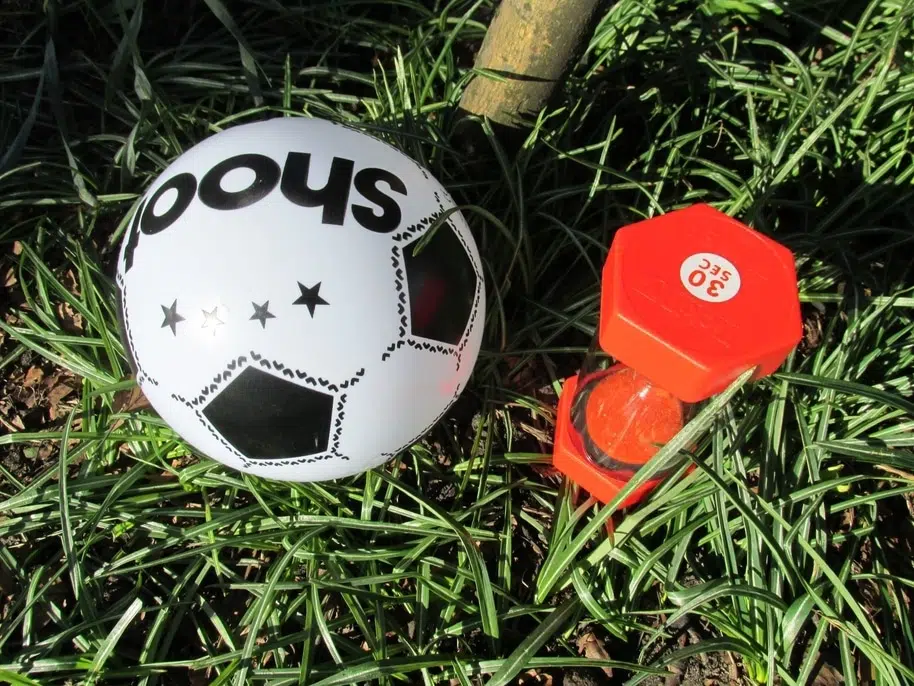
The Games
Wow activities! Things You Might Never Have Thought Of
We’re going to start off with a few activities that really have that wow factor. Some of these take a bit more preparation, but the vast majority of the activities after these are really simple, and can be played with more or less no preparation at all.
1. A Ball Wall
This one takes a bit of DIY, but once you’ve made it you’ve got it forever.
The husband of one of the practitioners I worked with built this amazing ball wall. He used a pallett with lots of tubes and pieces of gutter screwed onto it.

The idea is that all the parts move. This really helps with problem solving and reasoning.
You use small balls like large marbles or golf balls. (If using marbles you may want to supervise, particularly if you have children that put things in their mouth)
There are many different paths you can create to get the balls down to the bottom of the ball wall. Fantastic for cooperation and just general thinking.
2. Addition Machine
This is another real wow activity!
Again, this one takes a bit of preparation, but once you’ve made it you’ve got it more or less forever.
For this you simply create a monster that looks a bit like the one below:
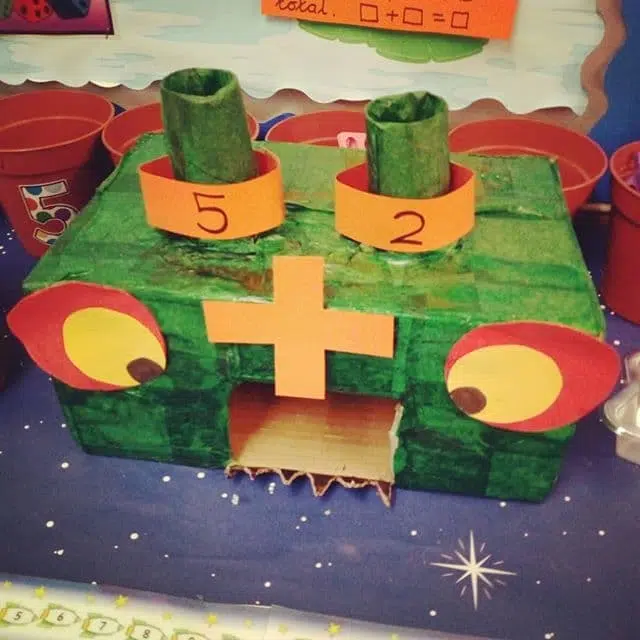
This was made by a fantastic lady that I used to work with.
This is a cardboard box covered in green crepe paper, jazzed up to look like a monster. It has two ears that are tubes, and that pass through into the box.
You have some rings with different numbers on that you put on the ears of the monster.
The idea is to put a ring on either ear, and then put that number of ping-pong balls down each ear. Count how many you have got at the bottom.
A really engaging maths and addition activity.
3. Using Gutters For Addition
I see these gutters around a lot, and they are fantastic for adding.
All you need are the ball-pit kind of balls.
Create some sort of gutter structure for the balls to roll down. Then get a selection of two colours of balls.
Simply count out one quantity of one colour into the gutter, and then a quantity of another. For example, you could roll 4 red balls down the gutter, and then 3 green.
How many do you get at the end?
For children that are not really up to adding yet, just simply counting the balls as they pop out the end is a great activity to try.
4. Balance The Eye Balls
Smaller balls are fantastic for a range of fine motor challenges.
In this activity I used golf balls painted to look like eyeballs. I just used acrylic paint. You could also use ping-pong balls, or polystyrene balls.
The appeal of eyeballs to children is a thing to behold! They love their gory and gruesome nature!
The idea of this activity is to get lots of golf tees. Then you simply stick the golf tees into different things. It could be into a pumpkin, or into plasticine.
In the picture the golf tees have been superglued into a slab of wood with holes drilled into it. The golf tees are also numbered 1-20 to make a fantastic active number line. This creation was another product of the guy that built the ball wall – an absolute genius.
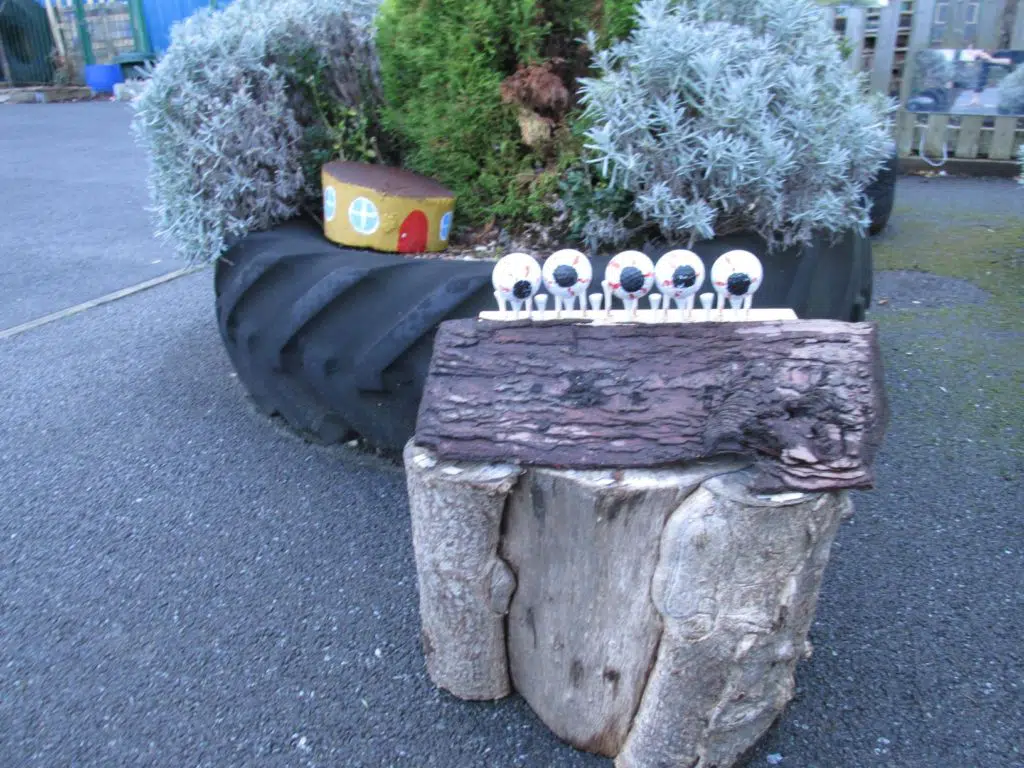
You can write numbers on the eyeballs and try to order them. You could add eyeballs painted in different colours.
All sorts of skills are possible.
5. Fine Motor Football
They really love this! The idea is to either use a small ball like a ping-pong ball, or alternatively you can use something like a pompom, or even a ball made of play dough.
The idea is to use craft sticks, or match sticks as the footballers.
Have two goals – the children can make the goals themselves. It could be two stones, or two lumps of playdough with craft sticks stuck into them to make the posts of the goal.
The children hold the craft or match sticks and hit the ball around the ‘field’. The field could be a tough spot, or a tray, or even on the floor.
The can play their friend, or cooperate and do things like football drills or dribbling round the cones.
This activity is great for fine motor. The footballer sticks encourage the children to use a pincer grip, and develop the muscles in their fingers – the same muscles that they will be using when they write.
It is also great for early maths. Players can count their score, or you could put numbers on the footballers. For many more exciting playdough maths games you can check this article out.
Cooperation Ball Games
Games involving balls are excellent for developing physical development, as well as being a perfect vehicle for all sorts of cooperation and friendship games. Here are some great examples:
6. Bridge Ball
In this game you need a minimum of four children, but it can be a much larger number.
The idea is that you stand in a circle and spread your legs wide. These are the ‘bridges’.
You need to stand in a way that your foot is touching the foot of the person next to you. There will be a circle of ‘bridges’ with no space in between.
Have one large ball, such as a sponge football. One player has the ball to start with. The idea is that they try to roll the ball through the legs of one of the other players. You can choose to roll it through anyone’s legs that you like.
That player will try and block the shot with their hands. They then try to roll the ball through someone else’s legs.
Keep going like this, trying to score a goal, and everyone trying to block everyone else’s shots. If you score, try and keep your own total by counting.
Remember, it is a rolling game, not a throwing game.
7. Thank You Game
This is a fantastic game for teaching children good manners.
The idea is that you sit in a circle. The adult starts. Say a child’s name and roll the ball to them. They say ‘thank you’. Then they say another child’s name and roll the ball to them. The say ‘thank you’, and repeat.
This is great for eye contact which is a massive target for many children these days. Want to find out many more good eye contact games? Why not read Children’s Eyes Contact Games – 12 Brilliant Group Ideas.
8. Pass The Ball Round The Circle
This starts super easy, but you can make it harder if they get really good at it.
The simplest way to play the game is to sit in a circle, and pass a ball around.
To make it trickier have several balls going at once. This is good for teamwork and cooperation. It is also good for awareness and responding to the world around them.
Next step is to have two different colours of balls. One colour goes one way around the circle, and the other colour goes the other way. This is quite hard if you are one of the people that has to pass one ball one way, whilst simultaneously passing the other in the opposite direction.
9. Change!
This is the next step for the passing the ball game.
To start with have one ball going in a direction around the circle. When you shout ‘change’ the ball goes in the opposite direction.
You can extend this to having two balls in action, which both change direction when you shout.
The next step, which is much harder, is having two colors of balls from start. The idea here is that one color goes one way, and one goes the other. When you say ‘change’ both then go the opposite direction. Lots of thinking and teamwork mixed together!
10. Time Challenge!
This is another passing balls game. Have a bag of balls and a sand timer – ideally either a 30 second timer or a minute.

The idea of this is how many balls can you pass round the circle in the time limit?
Pass the balls round, and the person who is last in the circle puts them into the bag. When the timer has finished count how many you got around.
You can make this more competitive by having two teams. They both try and get the highest score. This is good for counting, and also effective for learning about which number is greater or less.
There are many more games like this in my article 21 preschool circle time games that really work!
11. Pass The Ball With Your Feet!
This is a really fun party-game style activity. It is based on the passing the ball round the circle game, but this time you can only use your feet!
You could have a few balls going at once so they don’t have to wait too long to have their go! They can use their hands a bit as well if it’s a bit challenging for them.
Most children really love this game.
12. Drop
This is excellent for children that get very possessive about toys or objects, and don’t want others to touch them.
The idea is that everyone has a ball. The children move around the space you are in with the ball (walking to start).
Have an instrument, for example a drum. When you hit the drum the children put their ball on the floor then continue walking round the space. When you hit the drum again the children pick up the ball that is closest to them.
The idea is not just to pick the same ball up again and again, but pick up different balls. There is no ‘my ball’ in this game.
To extend it you can move in different ways around the space. For example, skipping, hopping, jumping, or jogging.
13. Thief In The Night!
This is a really fun listening game. You can also play it with a balloon (as you can many of these ball games). If you are interested in balloon games, then take a look at 30 Brilliant Balloon Games (That Work!)
Have a circle of children, and pick one of them to sit in the middle of the circle. They wear a blindfold.
Put the ball behind the child. They are going to pretend to be ‘asleep’.
Have a noisy instrument like bells or a tambourine. Give the instrument to one of the children in the circle. Their job is to stand up carrying the instrument, sneak over to the child and rob the ball. They go back to their place and try to put the instrument and the ball behind their back.
Get everyone to put their hands behind their backs, so it could be anyone.
Then take the child’s blindfold off. They have three guesses to guess who has robbed the ball!
There is almost always lots of sound-clues regarding where abouts the robber is sitting.
Parachute Ball Games
Parachutes are a great resource for teaching skills of teamwork, cooperation, and physical development. Here are some great parachute ball games:
14. Have Numbers Or Sounds On The Top Of The Parachute
If you have big sound or number mats they work really well for this. Get the children to hold the parachute at about waist height in a circle.
Have a ball that you put on the parachute. Say a number, e.g. 7. The idea is the children cooperate to roll the ball around the parachute until it touches number 7. When they manage it go on to the next number.
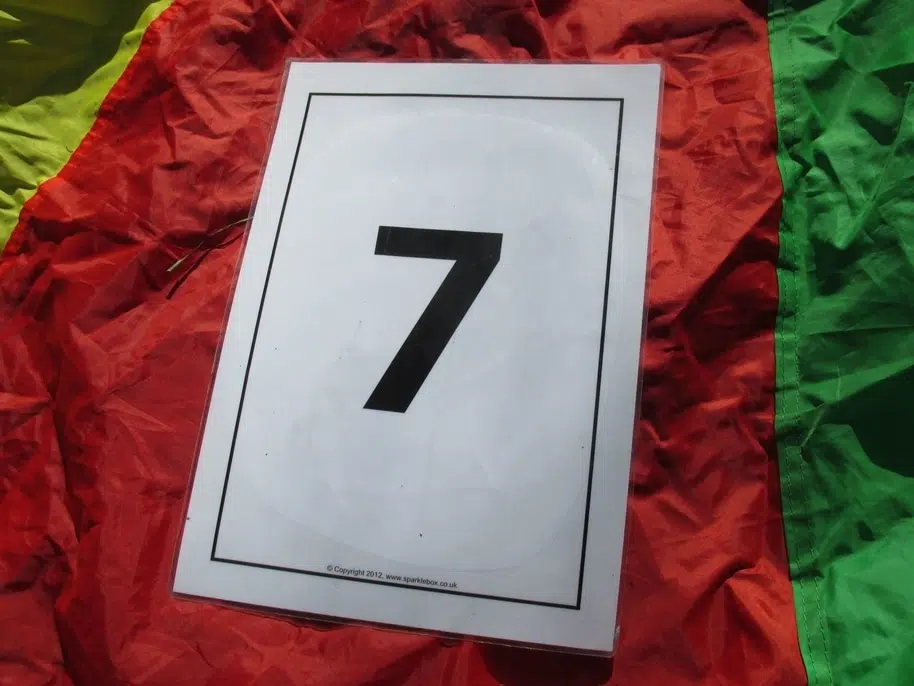
15. Bouncing Balls!
Have two teams of children for this. One team are holding the parachute, the other team are spaced out around it, ready to retrieve.
Put lots of sponge balls onto the parachute.
The team holding the parachute are going to try to bounce all the balls off.
The other team are going to run around and put all the balls back on! Just keep going and see how they get on. When they’ve done that for a couple of minutes swap places, and the bouncing team can have a go of retrieving.
Another really great teamwork game.
16. Rain
This is super simple good fun.
Have lots of soft balls, such as sponge balls about the size of tennis balls. It’s time to make the rain!
The idea of this is just to bounce all the balls into the air! Keep bouncing until they’re all off the parachute. They will come down a bit like ‘rain’. Some need more bounces to get off the parachute than others.
17. Cooperation Roll
This is a game where you all work together.
Have one quite large ball on the parachute. The idea of this game is to try to roll the ball around the edge of the parachute. Keep it close to the edge, and see if you can get it go in circles all the way around a few times.
There will be a few hairy moments when it either falls off the edge, or nearly falls off, but just put it back on and keep going.
18. Roll A Ball Off The Other Side
This is a more competitive game.
Have two teams, one on one side of the parachute, and the other team on the opposite side. Have a ball in the middle.
The idea is that one team are going to try to roll the ball over to the other side, and get it to go off the parachute on that side. The other team are trying to stop them, and get the ball to roll off on the other side.
Keep score whenever they manage to roll it off.
This is super for hand-strength as well as being great for any competitive children.
19. Cooperate To Bounce The Ball Up Into The Air
This is super simple.
Have a ball in the middle of the parachute. Cooperate together to bounce it up into the air.
This can be extended to a number game. Count the bounces!
This is a simple and fun way to practise one to one counting. To find out what one to one correspondence is, and the best ways to teach it, then take a look at this article.
Math Ball Games
All sorts of counting and number activities can really be brought to life with ball games. Here are some great examples:
20. Have Bibs With Numbers
Have shirts or bibs with numbers on that the children wear. If you don’t have anything like this, you can write numbers on stickers and they stick them on their tops.
Stand in a circle.
The first child says a number that someone else is wearing and throw the ball to them. That person says ‘thank you’. Then that person chooses someone else, says their number and throws it to them.
This game can be done as a rolling game, if they are struggling with catching.
Great for numeral recognition in a fun context. To find out 16 exciting ways to teach number recognition then take a look at this.
21. Write Numbers On The Balls
Either put stickers with numbers on onto balls, or write directly onto them if you don’t mind have permanent number balls.
Again this could be a rolling game or a throwing game, depending on the skills of the children.
Start with one ball, but you want to quickly extend it to at least two and hopefully more.
One child says someone’s name, and throws a ball to them. That child catches it and says the number.
Then they say someone else’s name, and throw it to them. Repeat.
If you have two or three balls going at once there is lots of communication and teamwork required.
22. Pass The Number Balls Round The Circle
Using the same balls that you created for the last game, play a simple numeral recognition game.
The children sit in a circle, and pass the balls round. When they are holding a ball they say the number that is written on it, before passing the ball to the next person.
This game is good because even if you don’t recognise all the numbers, you can listen to the person next to you and copy what they have said. Hopefully in this way you are absorbing what the numbers are in some way.
For those that know the numbers already, it is great for speed and quick recognition practice.
23. Ten Pin Bowling!
Have some pins or skittles. Just try to knock them down with a ball and count how many you got.
This activity is great for number bonds. If there are four knocked down then there are six stood up. This is a super play activity for just starting this process of addition.
Phonics Ball Games
Opportunities to take phonics outside, and practice skills in a fun context is always a good idea for engagement and catching children’s interest. Here are some good examples:
24. Penalty Shoot Out!
Have some balls, and either put stickers with words or sounds onto the balls, or write them directly on.
You need some sort of goal for this.
Put the balls with words or sounds on near each other in a line near the goal. One child goes first.
Say a word or sound, e.g. ‘a’. The idea is that child is going to kick the ball with the ‘a’ on and try to score a goal!
Repeat with different children and different sounds/words.
To make it harder you can add a goal keeper.
25. Kicking Word Balls
Have balls with simple words written on them. For example, they may have the words ‘I’, ‘can’, ‘kick’, ‘hop’, ‘jump’, ‘sit’, and other words such as that.
The idea of this is to try to build a caption or simple sentence. It could be ‘I can sit’. Put the balls next each other.
A fun way of really bringing it to life is saying each word as you kick the ball – ‘I’ (kick), ‘can’ (kick), ‘sit’ (kick).
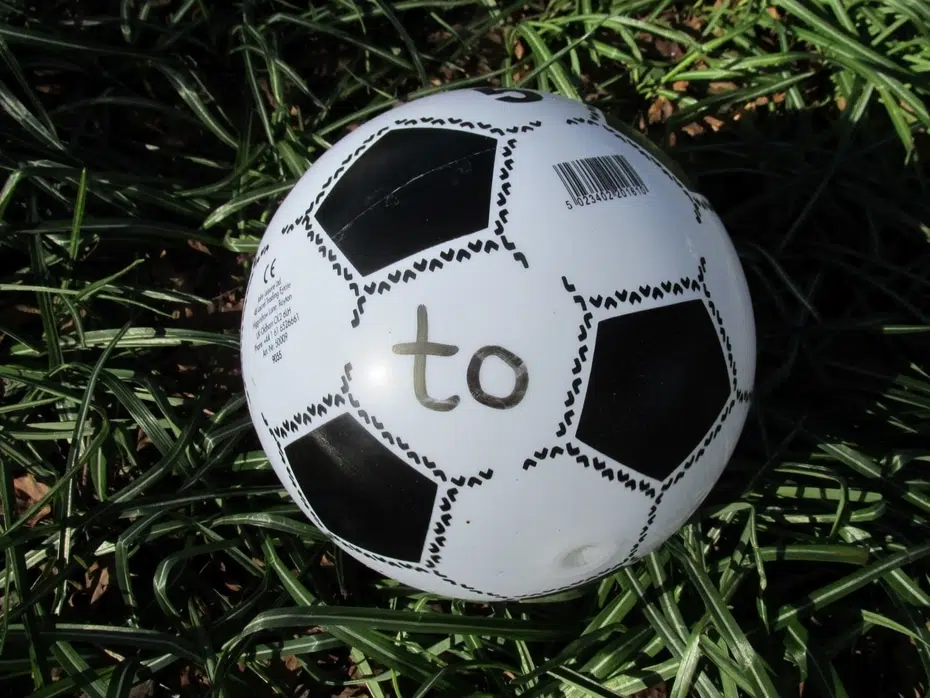
26. Pass Round The Balls With Sounds/Words On
Sit in a circle and pass the balls round with sounds on.
Whatever word you are holding say the sound. Then pass it on to the next person.
You can mix it up by saying ‘change’ occasionally and the balls all change direction.
27. Throw The Balls In The Bucket
Have some buckets or boxes with sounds or words on.
The idea of this is you simply say a sound or word, and a child has to throw the ball into that bucket or box.
This is a great independent activity.
Physical Development Games
Balls are naturally excellent for developing children physically. They nurture their coordination, agility and confidence in moving their bodies. Here are some simple balls games to get them started in this process:
28. Relay Throwing
This is good with two teams, but you can do it with just one long line.
Have two teams in two lines. They all stand about five steps apart in a long line.
The person at one end of the line starts with the ball. They are going to throw it the next person in the line (or roll it). They catch it or pick it up, turn round the throw to the next person in the line.
The idea is to get the ball to the end of the line before the other team.
29. Ten Throw Sit
This is very simple.
Stand with a partner facing you, and one ball between you. You can have lots of partners playing against each other.
When someone says ‘go’, the partners all try to throw and catch the ball ten times between them. They count as they go along, and when they get to ten they sit down.
The first partners to sit down are the winners (if you are doing the competitive version). For non-competitive, just see if they can all get to ten.
30. Tidy Up!
Most children need a bit of practice with this skill.
Get to to get all the balls you have out and scatter them all over the place. Have a time-limit, e.g. 1 minute.
Ready, steady, tidy up!
The big rule is that you can only pick up one ball at a time. Run with it back to the bags or boxes for the balls.
It’s good if you have different types of balls, because then they can sort them between the bags or boxes.
Conclusion
Good luck playing these ball games! Some take a bit of preparation, whilst some take almost no setting up at all.
Ball games really can be used to develop skills across the whole curriculum, and they get children interested and excited about learning.
If you’ve enjoyed these games, then why not take a look at these articles:
